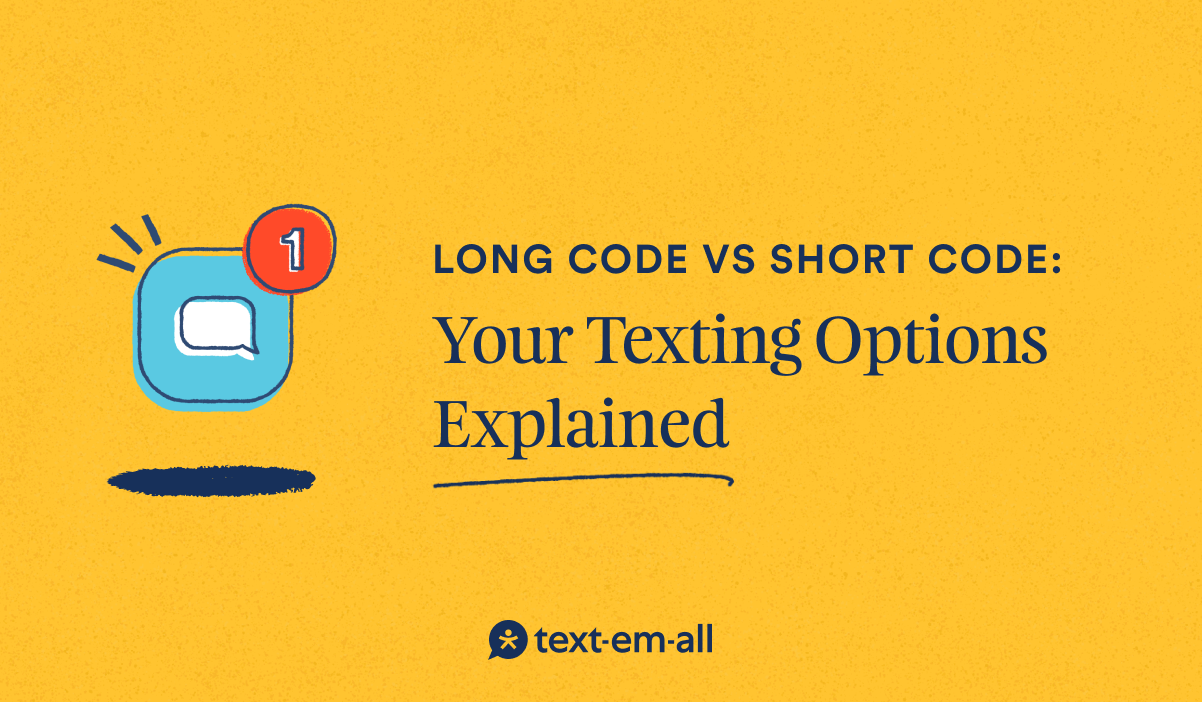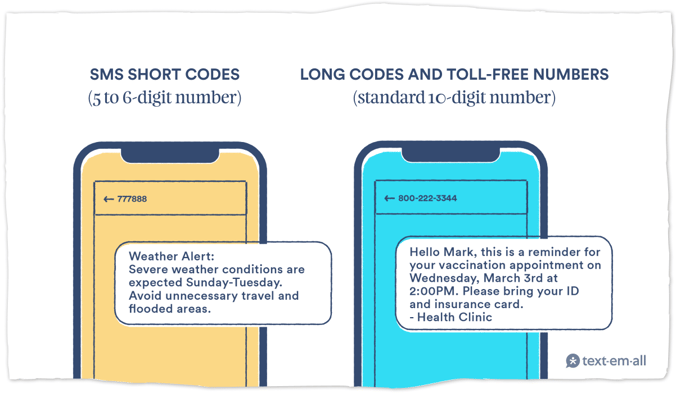3 min read
Long Code vs. Short Code: Business Texting Options Explained
![]() Brad Herrmann
:
Feb 15, 2024
Brad Herrmann
:
Feb 15, 2024

With Americans sending and receiving an average of 32 messages daily, mass texting has become indispensable for business communication. Whether sending employee communication, order updates, or appointment reminders, mass text messaging provides a direct and efficient way to reach contacts.
However, it’s not as simple as sending a text. One of the first decisions you’ll need to make is which type of number to use: a long code, a short code, or a toll-free number. To determine which is right for you, let’s examine the differences, advantages, and limitations between these options.
Understanding Short Codes
Short codes are abbreviated phone numbers typically consisting of five to six digits. They are specifically designed for mass messaging and are commonly used for shipping notices, flight updates, big brand marketing, and two-factor authentication (2FA).
For example, Southwest Airlines uses a short code to send flight reminders, delays, changes, and cancellations.
The Advantages of Using Short Codes
The primary advantage of short codes is their ability to reach a large audience quickly through a text blast. They are ideal for time-sensitive marketing promotions or emergency alerts where quick delivery is essential.
Short codes also offer enhanced deliverability and reliability, as they are less likely to be filtered by carriers than long codes.
The Limitations and Challenges of Using Short Codes
While upfront they might seem convenient, short codes come with a variety of challenges, including:
- Cost: Short codes start at $1,000 monthly on top of per-message fees.
- Application: Acquiring a short code can be time-consuming, requiring a significant application.
- Recognition: Because they are abbreviated, short codes often give the impression that you’re being texted by a chatbot or automated system, which could impact customer trust and engagement.
- No-Sharing: In the past short codes could be shared across different organizations, but carriers stopped allowing this to help prevent spam.
Understanding Long Codes (10DLC Numbers)
Long codes, or 10DLC numbers, are standard, 10-digit phone numbers used for text messaging. They are typically associated with personal or individual communication but have also found their place in business communication.
Due to their familiarity and accessibility, long codes are often used for informational messages, customer service inquiries, appointment scheduling, and general business communications.
The Advantages of Using Long Codes
10DLC texting provides several advantages over traditional short code texting:
- Affordability: Short codes are expensive to establish, and carriers no longer support sharing of short codes.
- Fewer blocks: Long codes are considered more trustworthy by carriers, increasing the likelihood that a long code message will be delivered to the intended recipient.
- Better recognition: Long codes are local numbers, and as such, they resemble traditional phone numbers, providing a familiar experience for customers.
Conversational messaging: Long codes allow customers to initiate a conversation with a business through text messaging, similar to a customer service line.
The Challenges of Using Long Codes
Before 2022, U.S. carriers limited long codes to P2P (person-to-person) messages, which meant they couldn’t be used for high-volume business applications. However, in 2022, local numbers were officially sanctioned for business text messaging, making them functionally similar to toll-free numbers.
If you’re sending enough business messages from your long code, you’ll have to register your text number. However, if you’re using Text-Em-All, we’ll walk you through the process and ensure you’re taken care of.
Short Code vs. Long Code: Key Differences
It’s easy to see several key differences when comparing short codes and long codes.
|
Criteria |
Long Codes |
Short Codes |
|
Length |
10-digit numbers |
5-6 digit numbers |
|
Use Cases |
Reminders, customer service, appointment scheduling |
Big brand marketing, flight updates, shipping notices, 2FA |
|
Cost |
Affordable setup and usage |
Higher acquisition and usage costs |
|
Delivery Speed |
Limited throughput |
High throughput |
|
Regulations |
Minimal regulatory requirements |
Stringent regulatory approval process |
In short, the choice between long and short codes ultimately depends on your business’s specific needs, goals, and budget constraints.
Choosing Between Long Codes and Short Codes
When deciding between long codes and short codes, several factors should be considered:
- The nature of the business communication: For personalized interactions and customer service, long codes may suffice, while SMS marketing campaigns may require the scalability of short codes.
- The volume of messages: Businesses with high message volumes may benefit from the speed and throughput of short codes.
- Budget: Long codes offer a cost-effective solution for businesses with limited budgets, while short codes require a more substantial investment.
- Regulatory compliance: Depending on the industry and messaging content, businesses may need to comply with specific regulatory requirements, which can influence the choice between long and short codes.
Read: 6 Tips for Writing an Effective Text Message
But What About Toll-Free Numbers?
Toll-free numbers are another option for businesses using mass texting and automated calling. However, it’s essential to understand that toll-free numbers aren’t the right fit for many companies unless you send an extremely high volume of messages daily.
These 8xx numbers have been a popular option for mass texting in recent years, and even the majority of our customers used toll-free numbers for the past few years. However, when the carriers cracked down on spam in 2022, they added a lot of additional costs and regulations to toll-free numbers.
Investing in a toll-free number may not be justified for businesses with lower message volumes or those primarily focused on one-on-one interactions. Long codes, or local numbers, may provide a more cost-effective and straightforward solution for SMS communication.

Launch Your Outreach Initiatives with Text-Em-All
In short, whether to pick long or short codes depends on factors like the type of communication, message volume, budget, and regulatory requirements you’re subject to. Knowing the differences between these options is vital if you’re aiming to improve your communication strategy.
If you’re looking for a platform to help you decide on the right solution, try Text-Em-All! Most of our customers use long code numbers; however, we can help you determine if you need a toll-free number based on your volume. Create your free account and start sending messages with us today!









